Perilla Seed Meal Extract Enriched with Rosmarinic Acid and Luteolin: Natural Active Pharmaceutical Ingredients (NAPIs) for Osteoprotective Effects
Abstract
1. Introduction
2. Materials and Methods
2.1. Reagents and Chemicals
2.2. Plant Extraction
2.3. Flavonoid and Phenolic Compound Determination
2.4. Cell Culture and Cytotoxicity Test
2.5. Effect of PSMEs on Intracellular ROS Production
2.6. Effect of PSMEs on Bone Formation Parameters
2.7. Alkaline Phosphatase (ALP) Activity
2.8. Alizarin Red S Staining
2.9. Osteocalcin (OC), Osteoprotegerin (OPG), and Receptor Activator of Nuclear Factor Kappa Ligand (RANKL) Determination
2.10. Statistical Analysis
3. Results
3.1. Flavonoid and Phenolic Compound Content
3.2. Effect of PSMEs on Cell Viability of hFOB 1.19 Cells
3.3. Effect of PSMEs on Intracellular ROS Production
3.4. Effect of Perilla Seed Meal Extracts (PSMEs) on Bone Formation Parameters
3.4.1. Effect of PSMEs on ALP in hFOB 1.19 Cells
3.4.2. Alizarin Red S Staining
3.4.3. Effects of PSMEs on OC, OPG, and RANKL Levels in hFOB 1.19 Cells
4. Discussion
5. Conclusions
Author Contributions
Funding
Institutional Review Board Statement
Informed Consent Statement
Data Availability Statement
Acknowledgments
Conflicts of Interest
References
- Amin, U.; McPartland, A.; O’Sullivan, M.; Silke, C. An overview of the management of osteoporosis in the aging female population. Women’s Health 2023, 19, 17455057231176655. [Google Scholar] [CrossRef]
- Sözen, T.; Özışık, L.; Başaran, N. An overview and management of osteoporosis. Eur. J. Rheumatol. Inflamm. 2017, 4, 46–56. [Google Scholar] [CrossRef]
- Sivakumar, S.; Melwyn, D.S.C.; Kumari, V.; Anandan, D.; Kumar, S. Understanding osteoporosis: A comprehensive review of risk factors, mechanisms, and management strategies. Int. J. Intell. Syst. Appl. Eng. 2024, 12, 2845–2855. [Google Scholar]
- Charoenngam, N.; Pongchaiyakul, C. Current issues in evaluation and management of osteoporosis in Thailand. Osteopor. Sarcopenia 2023, 9, 53–59. [Google Scholar] [CrossRef] [PubMed]
- Rashki Kemmak, A.; Rezapour, A.; Jahangiri, R.; Nikjoo, S.; Farabi, H.; Soleimanpour, S. Economic burden of osteoporosis in the world: A systematic review. Med. J. Islam. Repub. Iran. 2020, 34, 154. [Google Scholar] [CrossRef] [PubMed]
- Skjødt, M.K.; Frost, M.; Abrahamsen, B. Side effects of drugs for osteoporosis and metastatic bone disease. Br. J. Clin. Pharmacol. 2019, 85, 1063–1071. [Google Scholar] [CrossRef] [PubMed]
- Li, S.-S.; He, S.-H.; Xie, P.-Y.; Li, W.; Zhang, X.-X.; Li, T.-F.; Li, D.-F. Recent progresses in the treatment of osteoporosis. Front. Pharmacol. 2021, 12, 717065. [Google Scholar] [CrossRef]
- Poole, K.E.; Compston, J.E. Bisphosphonates in the treatment of osteoporosis. Br. Med. J. 2012, 344, e3211. [Google Scholar] [CrossRef]
- Sacco, S.M.; Horcajada, M.N.; Offord, E. Phytonutrients for bone health during ageing. Br. J. Clin. Pharmacol. 2013, 75, 697–707. [Google Scholar] [CrossRef]
- Hanga-Farcaș, A.; Miere, F.; Filip, G.A.; Clichici, S.; Fritea, L.; Vicaș, L.G.; Marian, E.; Pallag, A.; Jurca, T.; Filip, S.M.; et al. Phytochemical compounds involved in the bone regeneration process and their innovative administration: A systematic review. Plants 2023, 12, 2055. [Google Scholar] [CrossRef]
- Marcucci, G.; Domazetovic, V.; Nediani, C.; Ruzzolini, J.; Favre, C.; Brandi, M.L. Oxidative stress and natural antioxidants in osteoporosis: Novel preventive and therapeutic approaches. Antioxidants 2023, 12, 373. [Google Scholar] [CrossRef] [PubMed]
- Yang, Y.; Jiang, Y.; Qian, D.; Wang, Z.; Xiao, L. Prevention and treatment of osteoporosis with natural products: Regulatory mechanism based on cell ferroptosis. J. Orthop. Surg. Res. 2023, 18, 951. [Google Scholar] [CrossRef]
- Khanaree, C.; Punfa, W.; Tantipaiboonwong, P.; Suttajit, M.; Chewonarin, T.; Pangjit, K.; Pintha, K. The Attenuation of TNF-α-mediated Inflammatory Responses in Human Lung Adenocarcinoma Cell Line by Perilla Seed and Seed Meal Extract. Chiang Mai Univ. J. Nat. Sci. 2021, 20, e2021074. [Google Scholar] [CrossRef]
- Pusadee, T.; Prom-u-thai, C.; Yimyam, N.; Jamjod, S.; Rerkasem, B. Phenotypic and genetic diversity of local Perilla (Perilla frutescens (L.) Britt.) from northern Thailand. Econ. Bot. 2017, 71, 175–187. [Google Scholar] [CrossRef]
- Pintha, K.; Tantipaiboonwong, P.; Yodkeeree, S.; Chaiwangyen, W.; Chumphukam, O.; Khantamat, O.; Khanaree, C.; Kangwan, N.; Thongchuai, B.; Suttajit, M. Thai perilla (Perilla frutescens) leaf extract inhibits human breast cancer invasion and migration. Maejo Int. J. Sci. Technol. 2018, 12, 112–123. [Google Scholar]
- Ahmed, H.M. Ethnomedicinal, phytochemical and pharmacological investigations of Perilla frutescens (L.) Britt. Molecules 2019, 24, 102. [Google Scholar] [CrossRef] [PubMed]
- Wu, X.; Dong, S.; Chen, H.; Guo, M.; Sun, Z.; Luo, H. Perilla frutescens: A traditional medicine and food homologous plant. Chin. Herb. Med. 2023, 15, 369–375. [Google Scholar] [CrossRef] [PubMed]
- Li, H.; Lin, J.; Bai, B.; Bo, T.; He, Y.; Fan, S.; Zhang, J. Study on purification, identification, and antioxidant of flavonoids extracted from Perilla leaves. Molecules 2023, 28, 7273. [Google Scholar] [CrossRef]
- Hou, T.; Netala, V.R.; Zhang, H.; Xing, Y.; Li, H.; Zhang, Z. Perilla frutescens: A rich source of pharmacological active compounds. Molecules 2022, 27, 3578. [Google Scholar] [CrossRef]
- Guan, Z.; Li, S.; Lin, Z.; Yang, R.; Zhao, Y.; Liu, J.; Yang, S.; Chen, A. Identification and quantitation of phenolic compounds from the seed and pomace of perilla frutescens using HPLC/PDA and HPLC-ESI/QTOF/MS/MS. Phytochem. Anal. 2014, 25, 508–513. [Google Scholar] [CrossRef]
- Adam, G.; Robu, S.; Flutur, M.M.; Cioanca, O.; Vasilache, I.A.; Adam, A.M.; Mircea, C.; Nechita, A.; Harabor, V.; Harabor, A.; et al. Applications of Perilla frutescens extracts in clinical practice. Antioxidants 2023, 12, 727. [Google Scholar] [CrossRef] [PubMed]
- Khojasteh, A.; Mirjalili, M.H.; Alcalde, M.A.; Cusido, R.M.; Eibl, R.; Palazon, J. Powerful Plant Antioxidants: A New Biosustainable Approach to the Production of Rosmarinic Acid. Antioxidants 2020, 9, 1273. [Google Scholar] [CrossRef]
- Guan, H.; Luo, W.; Bao, B.; Cao, Y.; Cheng, F.; Yu, S.; Fan, Q.; Zhang, L.; Wu, Q.; Shan, M. A Comprehensive Review of Rosmarinic Acid: From Phytochemistry to Pharmacology and Its New Insight. Molecules 2022, 27, 3292. [Google Scholar] [CrossRef]
- Punia Bangar, S.; Kajla, P.; Chaudhary, V.; Sharma, N.; Ozogul, F. Luteolin: A flavone with myriads of bioactivities and food applications. Food Biosci. 2023, 52, 102366. [Google Scholar] [CrossRef]
- Phromnoi, K.; Suttajit, M.; Saenjum, C.; Limtrakul, P. Inhibitory Effect of a Rosmarinic Acid-Enriched Fraction Prepared from Nga-Mon (Perilla frutescens) Seed Meal on Osteoclastogenesis through the RANK Signaling Pathway. Antioxidants 2021, 10, 307. [Google Scholar] [CrossRef]
- Phromnoi, K.; Yodkeeree, S.; Pintha, K.; Mapoung, S.; Suttajit, M.; Saenjum, C.; Dejkriengkraikul, P. Anti-osteoporosis effect of Perilla frutescens leaf hexane fraction through regulating osteoclast and osteoblast differentiation. Molecules 2022, 27, 824. [Google Scholar] [CrossRef]
- Shetty, S.; Kapoor, N.; Bondu, J.D.; Thomas, N.; Paul, T.V. Bone turnover markers: Emerging tool in the management of osteoporosis. Indian J. Endocrinol. Metab. 2016, 20, 846–852. [Google Scholar] [CrossRef] [PubMed]
- Huang, S.; Nan, Y.; Chen, G.; Ning, N.; Du, Y.; Lu, D.; Yang, Y.; Meng, F.; Yuan, L. The role and mechanism of Perilla frutescens in cancer treatment. Molecules 2023, 28, 5883. [Google Scholar] [CrossRef] [PubMed]
- Zhang, Y.; Liu, M.; Ding, Y.; Wang, T.; Ma, Y.; Huang, J.; He, S.; Qu, Q.; Sun, F.; Lv, W.; et al. Effects of Perilla seed meal on productive performance, egg quality, antioxidant capacity, and hepatic lipid metabolism of Wenchang breeder hens. Animals 2023, 13, 3587. [Google Scholar] [CrossRef]
- Kim, J.M.; Liceaga, A.M.; Yoon, K.Y. Purification and identification of an antioxidant peptide from perilla seed (Perilla frutescens) meal protein hydrolysate. Food Sci. Nutr. 2019, 7, 1645–1655. [Google Scholar] [CrossRef]
- Selvakumar Periyasamy, D.; Sivashanmugam, P. Studies on the extraction of polyphenolic compounds from pre-consumer organic solid waste. J. Ind. Eng. Chem. 2019, 82, 130–137. [Google Scholar] [CrossRef]
- Oroian, M.; Ursachi, F.; Dranca, F. Ultrasound-assisted extraction of polyphenols from crude pollen. Antioxidants 2020, 9, 322. [Google Scholar] [CrossRef]
- Pattananandecha, T.; Apichai, S.; Julsrigival, J.; Ungsurungsie, M.; Samuhasaneetoo, S.; Chulasiri, P.; Kwankhao, P.; Pitiporn, S.; Ogata, F.; Kawasaki, N.; et al. Antioxidant activity and anti-photoaging effects on UVA-irradiated human fibroblasts of rosmarinic acid enriched extract prepared from Thunbergia laurifolia leaves. Plants 2021, 10, 1648. [Google Scholar] [CrossRef]
- Sukkho, T.; Khanongnuch, C.; Lumyong, S.; Ruangsuriya, J.; Pattananandecha, T.; Apichai, S.; Ogata, F.; Kawasaki, N.; Saenjum, C. Local wisdom and diversity of medicinal plants in Cha Miang Forest in Mae Kampong Village, Chiang Mai, Thailand, and their potential for use as osteoprotective products. Plants 2022, 11, 1492. [Google Scholar] [CrossRef] [PubMed]
- Bernar, A.; Gebetsberger, J.V.; Bauer, M.; Streif, W.; Schirmer, M. Optimization of the alizarin red s assay by enhancing mineralization of osteoblasts. Int. J. Mol. Sci. 2023, 24, 723. [Google Scholar] [CrossRef]
- Dai, J.; Mumper, R.J. Plant phenolics: Extraction, analysis and their antioxidant and anticancer properties. Molecules 2010, 15, 7313–7352. [Google Scholar] [CrossRef] [PubMed]
- López-Fernández, O.; Domínguez, R.; Pateiro, M.; Munekata, P.E.S.; Rocchetti, G.; Lorenzo, J.M. Determination of polyphenols using liquid chromatography-tandem mass spectrometry technique (LC-MS/MS): A review. Antioxidants 2020, 9, 479. [Google Scholar] [CrossRef]
- Lau, C.H.; Chua, L.S. Solubility models for the recovery of rosmarinic acid from Orthosiphon aristatus extract using solid phase extraction. Chem. Eng. 2019, 3, 64. [Google Scholar] [CrossRef]
- Elmowafy, M.; Shalaby, K.; Al-Sanea, M.M.; Hendawy, O.M.; Salama, A.; Ibrahim, M.F.; Ghoneim, M.M. Influence of stabilizer on the development of luteolin nanosuspension for cutaneous delivery: An in vitro and in vivo evaluation. Pharmaceutics 2021, 13, 1812. [Google Scholar] [CrossRef]
- Noor, S.; Mohammad, T.; Rub, M.A.; Raza, A.; Azum, N.; Yadav, D.K.; Hassan, M.I.; Asiri, A.M. Biomedical features and therapeutic potential of rosmarinic acid. Arch. Pharm. Res. 2022, 45, 205–228. [Google Scholar] [CrossRef]
- Tang, T.; Sun, M.; Sha, B.; Liu, R.; Ren, Z.; Li, L.; Zhang, Y.; Wang, H.; Yu, K. Protective effects of rosmarinic acid against oxidative damage and atherosclerosis via the PI3K/AKT pathway. Food Chem. Toxicol. 2025, 203, 115576. [Google Scholar] [CrossRef]
- Fernando, P.D.S.M.; Ko, D.O.; Piao, M.J.; Kang, K.A.; Herath, H.M.U.L.; Hyun, J.W. Protective effect of luteolin against oxidative stress-mediated cell injury via enhancing antioxidant systems. Mol. Med. Rep. 2024, 30, 121. [Google Scholar] [CrossRef] [PubMed]
- Mahwish; Imran, M.; Naeem, H.; Hussain, M.; Alsagaby, S.A.; Al Abdulmonem, W.; Mujtaba, A.; Abdelgawad, M.A.; Ghoneim, M.M.; El-Ghorab, A.H.; et al. Antioxidative and Anticancer Potential of Luteolin: A Comprehensive Approach Against Wide Range of Human Malignancies. Food Sci. Nutr. 2025, 13, e4682. [Google Scholar] [CrossRef] [PubMed]
- Trivedi, S.; Srivastava, K.; Gupta, A.; Saluja, T.S.; Kumar, S.; Mehrotra, D.; Singh, S.K. A quantitative method to determine osteogenic differentiation aptness of scaffold. J. Oral Biol. Craniofacial Res. 2020, 10, 158–160. [Google Scholar] [CrossRef] [PubMed]
- Vimalraj, S. Alkaline phosphatase: Structure, expression and its function in bone mineralization. Gene 2020, 754, 144855. [Google Scholar] [CrossRef]
- Golub, E.; Boesze-Battaglia, K. The role of alkaline phosphatase in mineralization. Curr. Opin. Orthop. 2007, 18, 444–448. [Google Scholar] [CrossRef]
- Lee, J.W.; Asai, M.; Jeon, S.K.; Iimura, T.; Yonezawa, T.; Cha, B.Y.; Woo, J.T.; Yamaguchi, A. Rosmarinic acid exerts an antiosteoporotic effect in the RANKL-induced mouse model of bone loss by promotion of osteoblastic differentiation and inhibition of osteoclastic differentiation. Mol. Nutr. Food Res. 2015, 59, 386–400. [Google Scholar] [CrossRef]
- Jeong, M.J.; Lim, D.S.; Kim, S.O.; Park, C.; Choi, Y.H.; Jeong, S.J. Effect of rosmarinic acid on differentiation and mineralization of MC3T3-E1 osteoblastic cells on titanium surface. Anim. Cells Syst. 2021, 25, 46–55. [Google Scholar] [CrossRef]
- Choi, E.-M. Modulatory effects of luteolin on osteoblastic function and inflammatory mediators in osteoblastic MC3T3-E1 cells. Cell Biol. Int. 2007, 31, 870–877. [Google Scholar] [CrossRef]
- Quan, H.; Dai, X.; Liu, M.; Wu, C.; Wang, D. Luteolin supports osteogenic differentiation of human periodontal ligament cells. BMC Oral Health 2019, 19, 229. [Google Scholar] [CrossRef]
- Nakamura, A.; Dohi, Y.; Akahane, M.; Ohgushi, H.; Nakajima, H.; Funaoka, H.; Takakura, Y. Osteocalcin secretion as an early marker of in vitro osteogenic differentiation of rat mesenchymal stem cells. Tissue Eng. Part C Methods 2009, 15, 169–180. [Google Scholar] [CrossRef]
- Zoch, M.L.; Clemens, T.L.; Riddle, R.C. New insights into the biology of osteocalcin. Bone 2016, 82, 42–49. [Google Scholar] [CrossRef]
- Berezovska, O.; Yildirim, G.; Budell, W.C.; Yagerman, S.; Pidhaynyy, B.; Bastien, C.; van der Meulen, M.C.H.; Dowd, T.L. Osteocalcin affects bone mineral and mechanical properties in female mice. Bone 2019, 128, 115031. [Google Scholar] [CrossRef]
- Boyce, B.F.; Xing, L. Functions of RANKL/RANK/OPG in bone modeling and remodeling. Arch. Biochem. Biophys. 2008, 473, 139–146. [Google Scholar] [CrossRef] [PubMed]
- Kitaura, H.; Marahleh, A.; Ohori, F.; Noguchi, T.; Shen, W.-R.; Qi, J.; Nara, Y.; Pramusita, A.; Kinjo, R.; Mizoguchi, I. Osteocyte-related cytokines regulate osteoclast formation and bone resorption. Int. J. Mol. Sci. 2020, 21, 5169. [Google Scholar] [CrossRef] [PubMed]
- Gao, Y.M.; Pei, Y.; Zhao, F.F.; Wang, L. Osteoclasts in osteosarcoma: Mechanisms, interactions, and therapeutic prospects. Cancer Manag. Res. 2023, 15, 1323–1337. [Google Scholar] [CrossRef] [PubMed]
- Lee, J.W.; Ahn, J.Y.; Hasegawa, S.; Cha, B.Y.; Yonezawa, T.; Nagai, K.; Seo, H.J.; Jeon, W.B.; Woo, J.T. Inhibitory effect of luteolin on osteoclast differentiation and function. Cytotechnology 2009, 61, 125–134. [Google Scholar] [CrossRef]
- Balci Yuce, H.; Toker, H.; Yildirim, A.; Tekin, M.B.; Gevrek, F.; Altunbas, N. The effect of luteolin in prevention of periodontal disease in Wistar rats. J. Periodontol. 2019, 90, 1481–1489. [Google Scholar] [CrossRef] [PubMed]
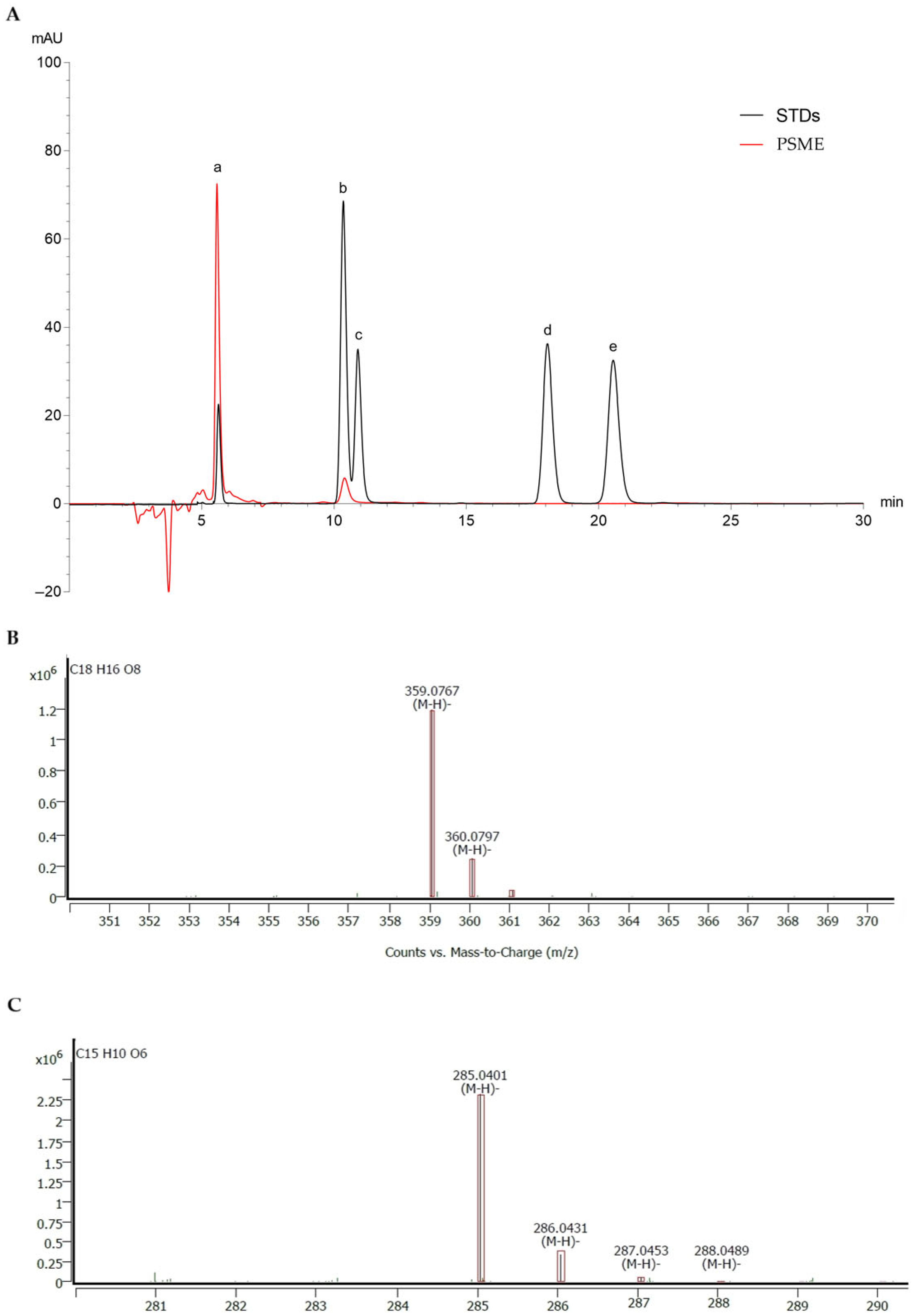
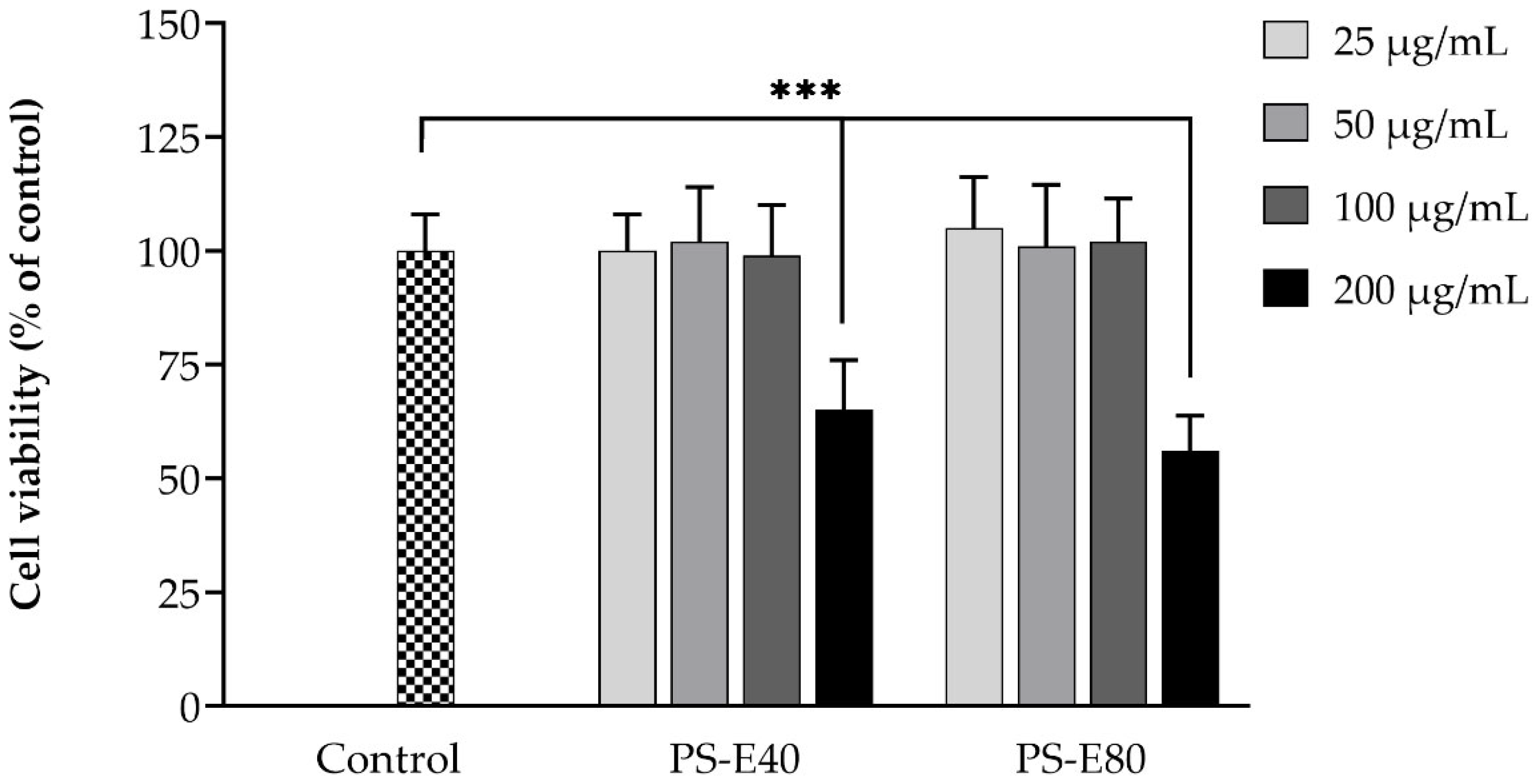
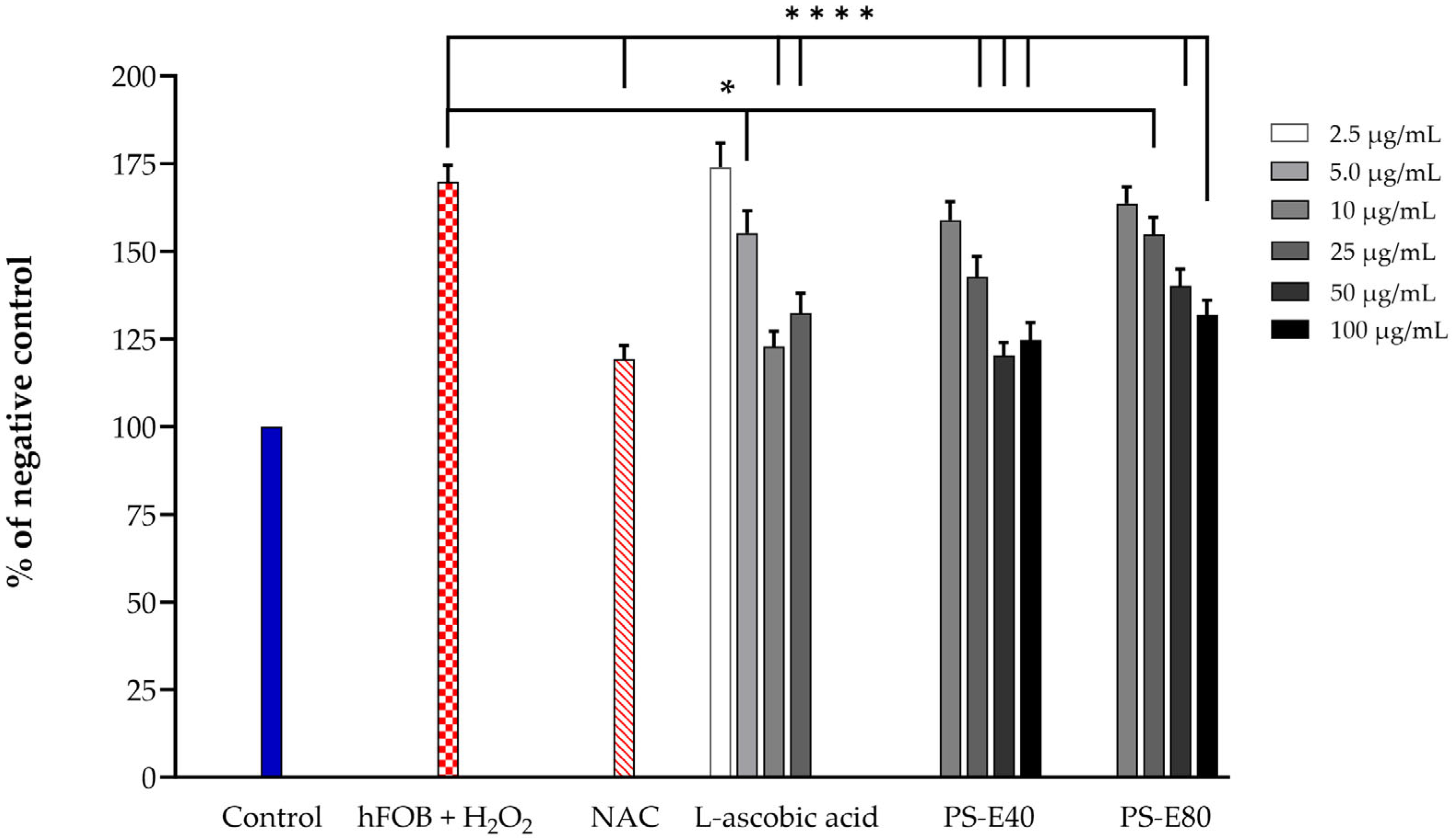
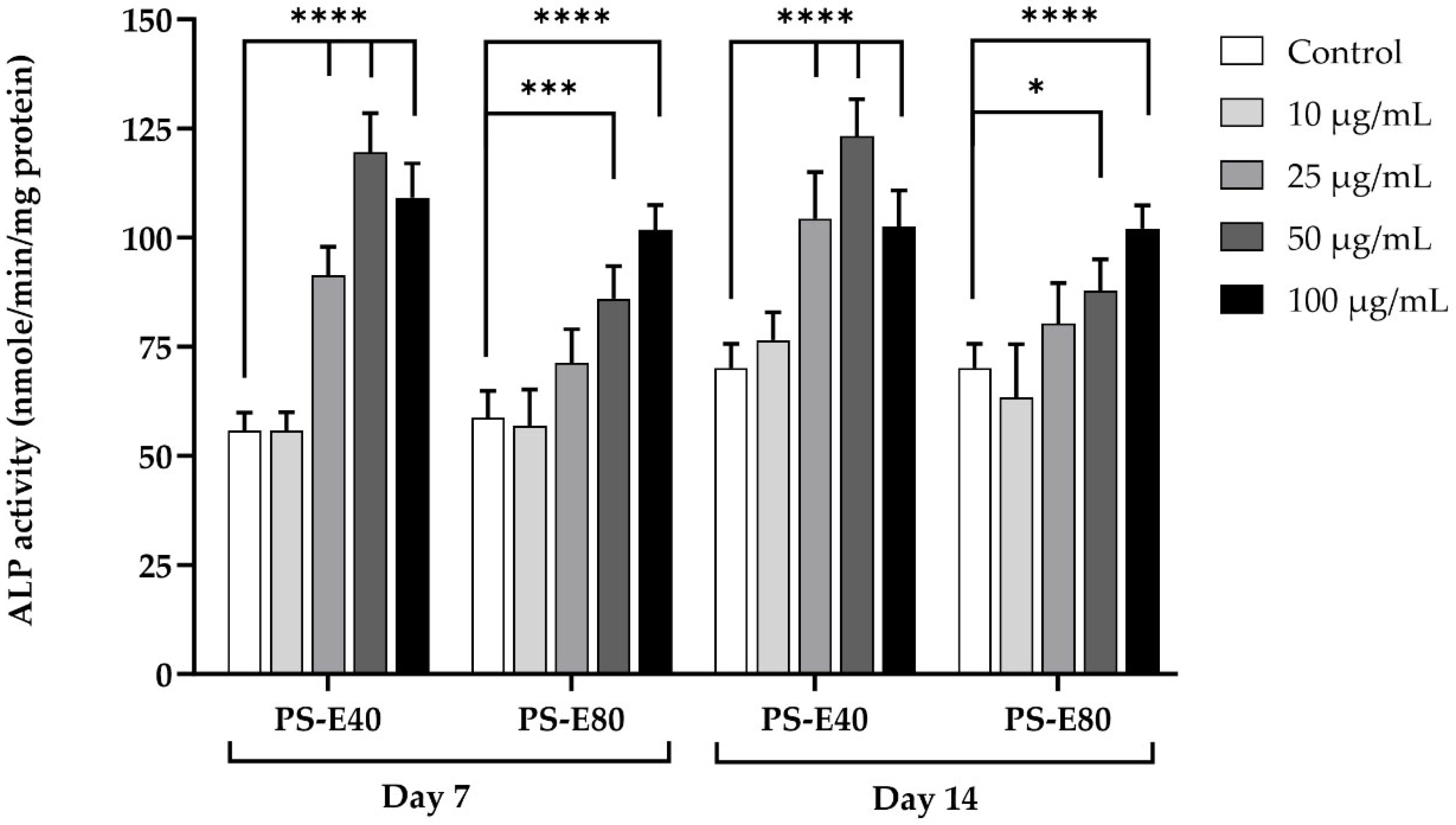
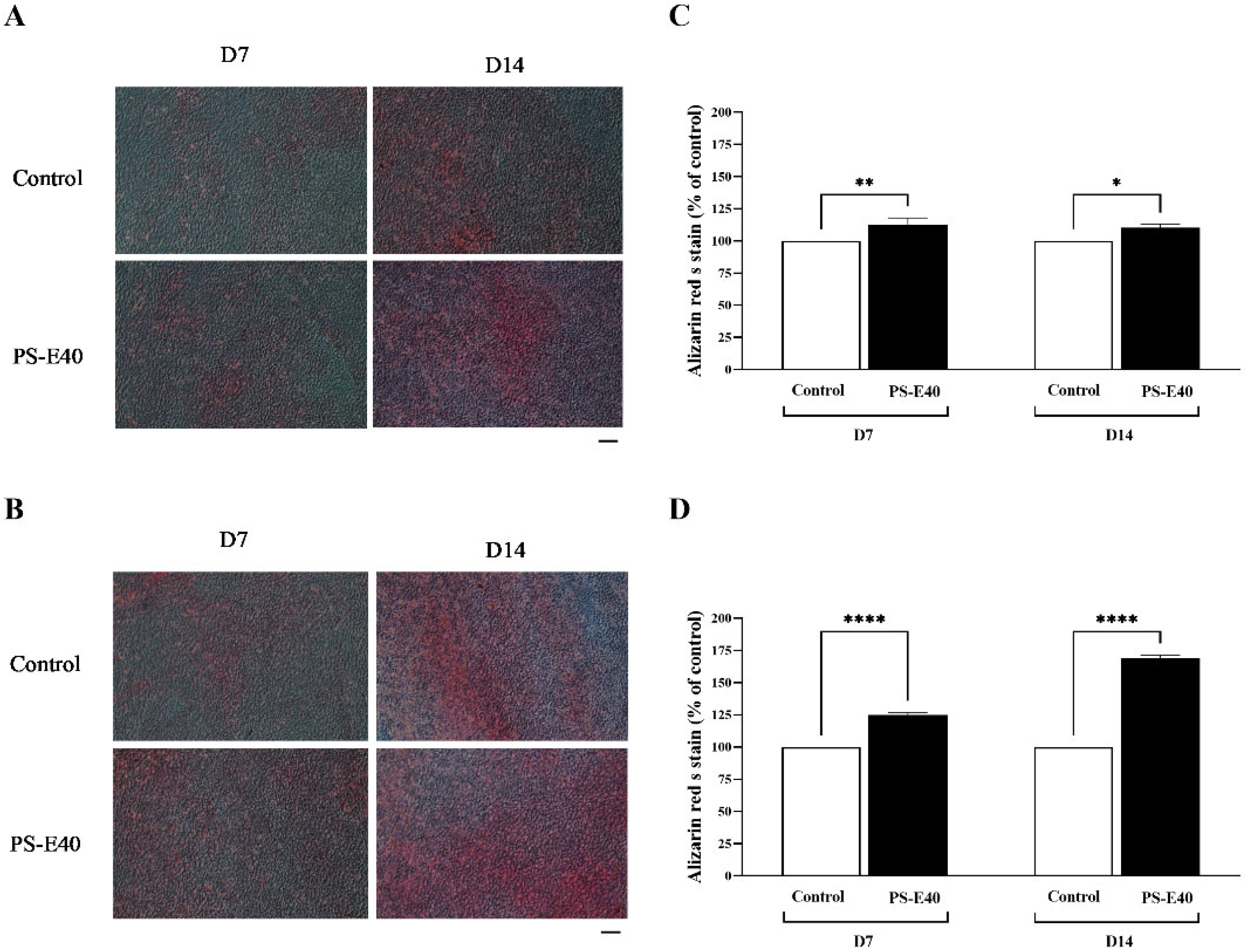
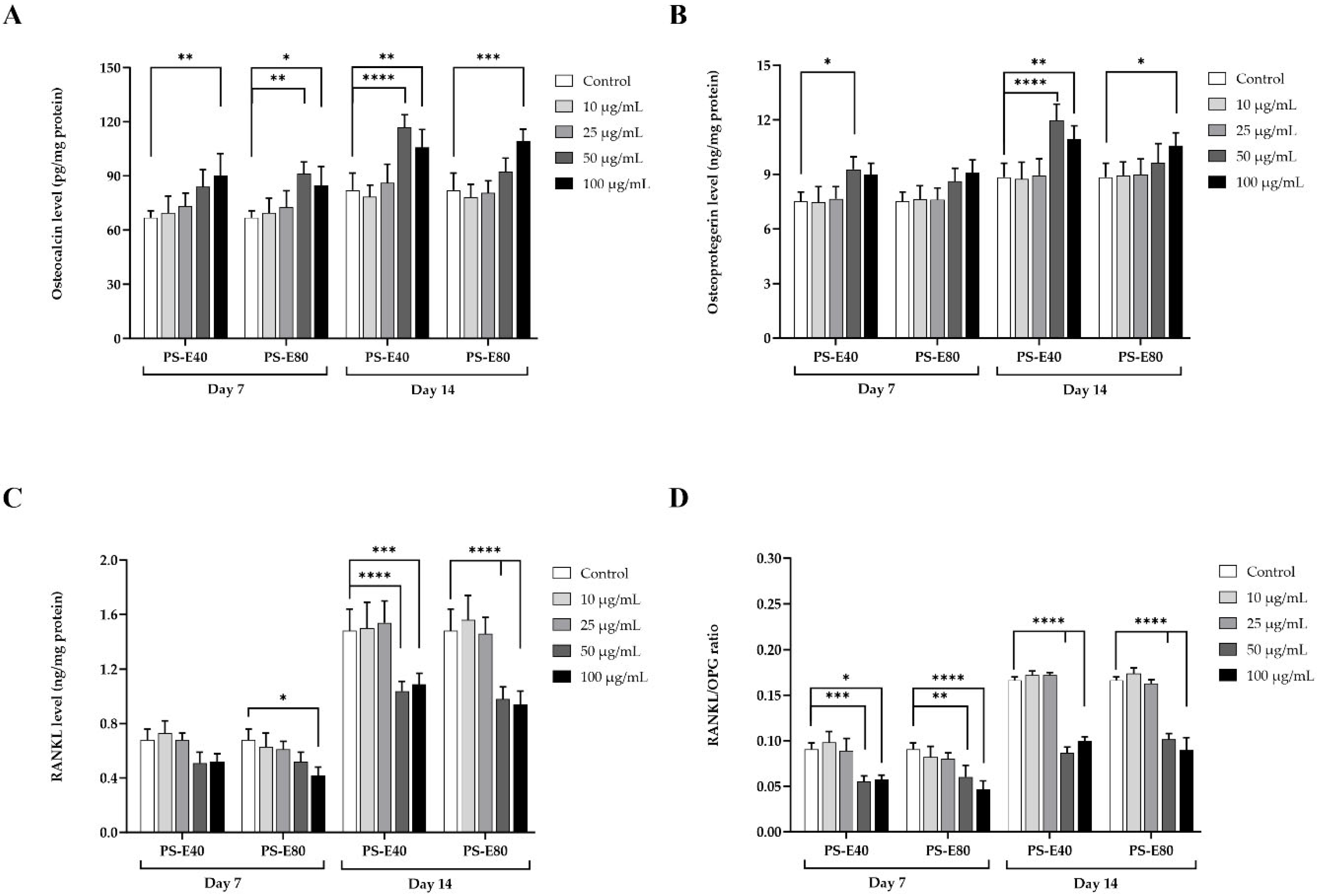
| Extraction Solvent | Shaking Incubation | Ultrasonic Extraction | ||
|---|---|---|---|---|
| Rosmarinic Acid (mg/g Extract) | Luteolin (mg/g Extract) | Rosmarinic Acid (mg/g Extract) | Luteolin (mg/g Extract) | |
| PS-DW | 121.90 ± 6.03 d**** | 1.17 ± 0.05 d | 89.46 ± 4.68 e | 0.89 ± 0.05 f |
| PS-E20 | 169.86 ± 3.00 b**** | 3.02 ± 0.10 c | 130.78 ± 3.14 b | 2.71 ± 0.07 e |
| PS-E40 | 189.62 ± 2.77 a**** | 5.03 ± 0.08 b**** | 152.27 ± 3.40 a | 3.56 ± 0.09 c |
| PS-E60 | 160.70 ± 3.07 b**** | 5.61 ± 0.11 b**** | 135.57 ± 5.31 b | 4.12 ± 0.05 b |
| PS-E80 | 147.04 ± 2.36 c**** | 6.90 ± 0.13 a**** | 117.85 ± 3.06 c | 4.98 ± 0.07 a |
| PS-E100 | 78.01 ± 3.34 e**** | 3.93 ± 0.84 c** | 47.88 ± 4.31 e | 3.04 ± 0.08 d |
Disclaimer/Publisher’s Note: The statements, opinions and data contained in all publications are solely those of the individual author(s) and contributor(s) and not of MDPI and/or the editor(s). MDPI and/or the editor(s) disclaim responsibility for any injury to people or property resulting from any ideas, methods, instructions or products referred to in the content. |
© 2025 by the authors. Licensee MDPI, Basel, Switzerland. This article is an open access article distributed under the terms and conditions of the Creative Commons Attribution (CC BY) license (https://creativecommons.org/licenses/by/4.0/).
Share and Cite
Pattananandecha, T.; Apichai, S.; Sukkho, T.; Ruangsuriya, J.; Ogata, F.; Kawasaki, N.; Saenjum, C. Perilla Seed Meal Extract Enriched with Rosmarinic Acid and Luteolin: Natural Active Pharmaceutical Ingredients (NAPIs) for Osteoprotective Effects. Antioxidants 2025, 14, 973. https://doi.org/10.3390/antiox14080973
Pattananandecha T, Apichai S, Sukkho T, Ruangsuriya J, Ogata F, Kawasaki N, Saenjum C. Perilla Seed Meal Extract Enriched with Rosmarinic Acid and Luteolin: Natural Active Pharmaceutical Ingredients (NAPIs) for Osteoprotective Effects. Antioxidants. 2025; 14(8):973. https://doi.org/10.3390/antiox14080973
Chicago/Turabian StylePattananandecha, Thanawat, Sutasinee Apichai, Treethip Sukkho, Jetsada Ruangsuriya, Fumihiko Ogata, Naohito Kawasaki, and Chalermpong Saenjum. 2025. "Perilla Seed Meal Extract Enriched with Rosmarinic Acid and Luteolin: Natural Active Pharmaceutical Ingredients (NAPIs) for Osteoprotective Effects" Antioxidants 14, no. 8: 973. https://doi.org/10.3390/antiox14080973
APA StylePattananandecha, T., Apichai, S., Sukkho, T., Ruangsuriya, J., Ogata, F., Kawasaki, N., & Saenjum, C. (2025). Perilla Seed Meal Extract Enriched with Rosmarinic Acid and Luteolin: Natural Active Pharmaceutical Ingredients (NAPIs) for Osteoprotective Effects. Antioxidants, 14(8), 973. https://doi.org/10.3390/antiox14080973








